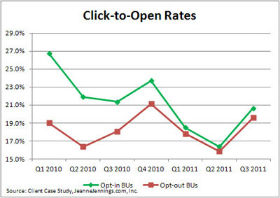The From Line
Sending, Managing & Monetizing Email
4 minutes reading time
(721 words)
Trend: Opt In vs Opt Out Lists: Is the gap closing?
Not so fast. There is a better way…
 It has long been accepted as an industry standard that list purchasing is a big no-no. However, as we know, there is always an exception to the rule. I came across a recent ClickZ study that looked into one company’s journey with a purchased list of email addresses. The results were unexpected, to say the least. The company sent the same message at the same time to two separate lists, one organic and one purchased. For all comparisons but one, the opt-in subscribers yielded better results. But when it came to the click-to-open rate, the data from 2010 to 2011 was quite surprising. There was only a 6% gap between opt-in and opt-out click-to-open rates in 2011. So what does this mean? Well, it looks like consumer habits are changing to reflect the shift in marketing to the email inbox. It’s possible that customers are becoming more trusting of senders, even if they don’t recognize them. I’d venture to guess that consumers have more confidence in the purity of messages that appear in their inbox, mostly due to recent SPAM laws and email filtering/importance ranking. Yes, these are intriguing results, but remember, this was only one study of one campaign sent by one company.
It has long been accepted as an industry standard that list purchasing is a big no-no. However, as we know, there is always an exception to the rule. I came across a recent ClickZ study that looked into one company’s journey with a purchased list of email addresses. The results were unexpected, to say the least. The company sent the same message at the same time to two separate lists, one organic and one purchased. For all comparisons but one, the opt-in subscribers yielded better results. But when it came to the click-to-open rate, the data from 2010 to 2011 was quite surprising. There was only a 6% gap between opt-in and opt-out click-to-open rates in 2011. So what does this mean? Well, it looks like consumer habits are changing to reflect the shift in marketing to the email inbox. It’s possible that customers are becoming more trusting of senders, even if they don’t recognize them. I’d venture to guess that consumers have more confidence in the purity of messages that appear in their inbox, mostly due to recent SPAM laws and email filtering/importance ranking. Yes, these are intriguing results, but remember, this was only one study of one campaign sent by one company. Takeaway: Do not let yourself be misguided by unscrupulous marketers.
As I mentioned earlier, list purchasing is still not considered an effective or for that matter, ethical practice. It’s highly doubtful that any of the addresses on a purchased list actually gave permission for their information to be bought and sold at will. However, this doesn’t mean we should discount the concept of creative list growth. There are other ways to supplement you marketing efforts that are related, but less detrimental to your reputation and lists. For example, this lovely idea of “list rental”: first let’s note that it isn’t necessarily a list RENTAL at all, in that the company “renting” the list does not actually even see the addresses. Messages are either sent by one company on the behalf of another or ad space is shared between the two companies. This is really only beneficial to both parties when they share a related industry or both can claim they market to similar clientele. It has the possibility of being successful ONLY if done with extreme care and focus. Still, I would say this is a little fishy. I personally, would feel a bit betrayed if a respected sender suddenly blasted me with information I had not asked for on the behalf of another vendor. And this is where another gray area comes in: how much can marketers guarantee that the addresses they’re sending to (which they never actually see) have truly given permission to receive third party information? They can’t.
Then what WILL work?
How To: Two heads are better than one. Collaboration will bring success.
If your email marketing program needs a boost, take a look into co registration. If executed correctly, a co registration campaign can help increase brand visibility and grow your lists. Also, it can prove to be quite cost effective. In a nutshell, it is a way to generate leads and find prospects. By leveraging a website’s sign-up process, co registration enables clients to build targeted lists of qualified customers that are actually interested in their products, services, and offers. Think of it this way, marketers are constantly sending out emails to their customers. These marketers would benefit from list growth, as would you. Wouldn’t it be nice to be able to tap into additional markets in an ethical way i.e. not buying a list? Then why not work together and share space in the emails you’re already sending and on the sites you currently maintain. Keep in mind though that there is a right and wrong way with co registration. Even though it is the most ethical option we’ve touched on, it can still be abused. To avoid this, there must be complete transparency between advertiser, publisher, and subscriber. As long as the proper guidelines are followed, this can be an easy way to add an additional layer to any marketing plan. Opt-in forms and shared ad space will create the most viable new leads.
For more detailed information on co registration, check out our white paper “Debunking Co-Registration Myths: How to get high-quality leads ethically, quickly and cost-effectively”
Stay Informed
When you subscribe to the blog, we will send you an e-mail when there are new updates on the site so you wouldn't miss them.
